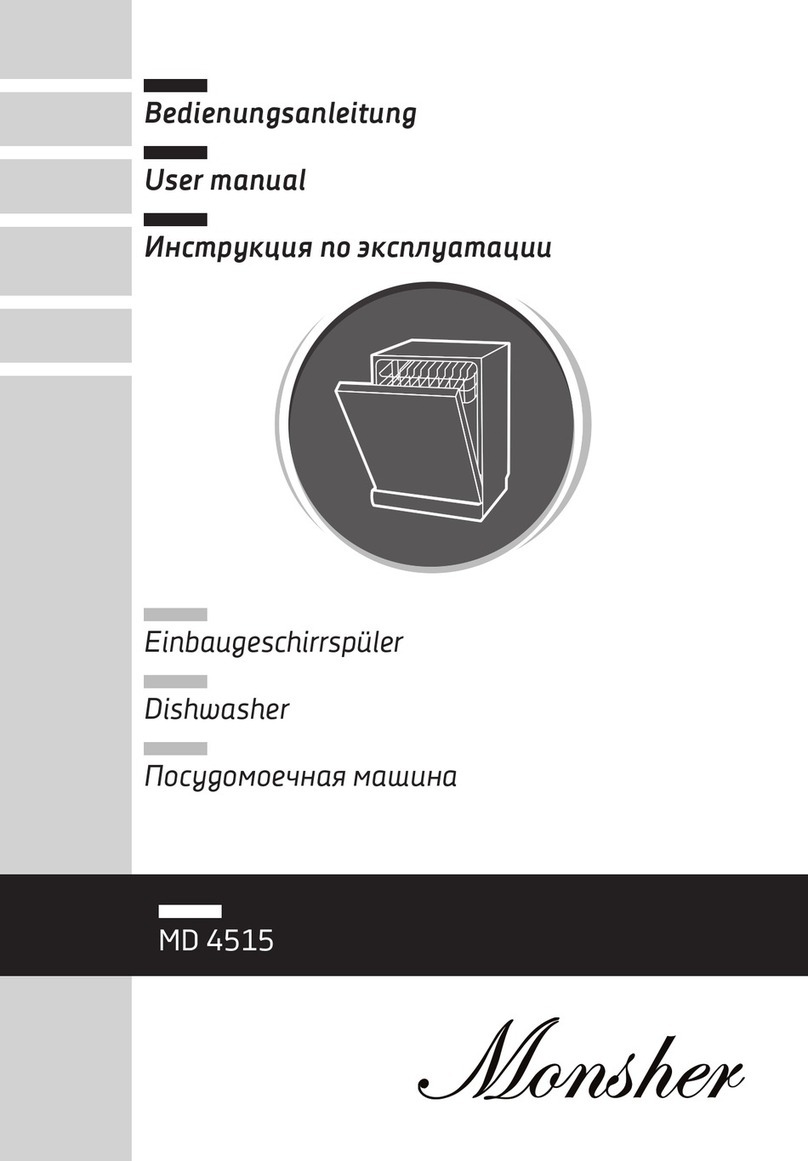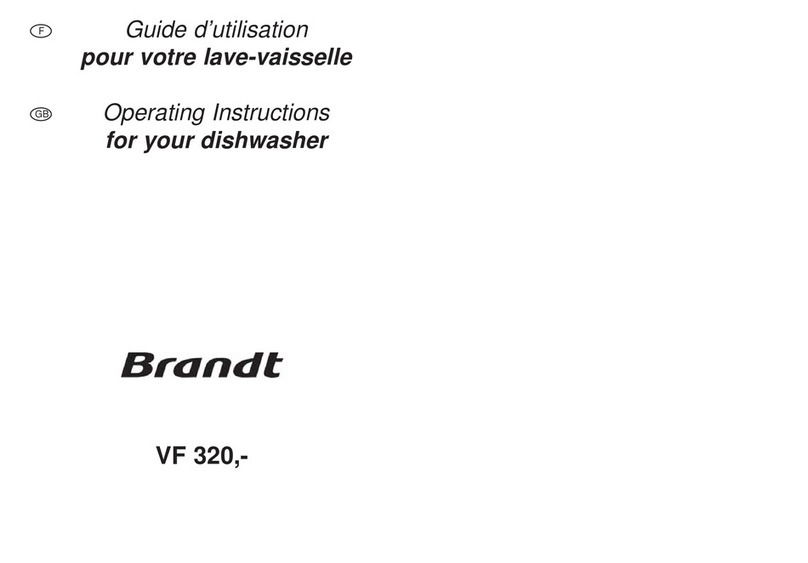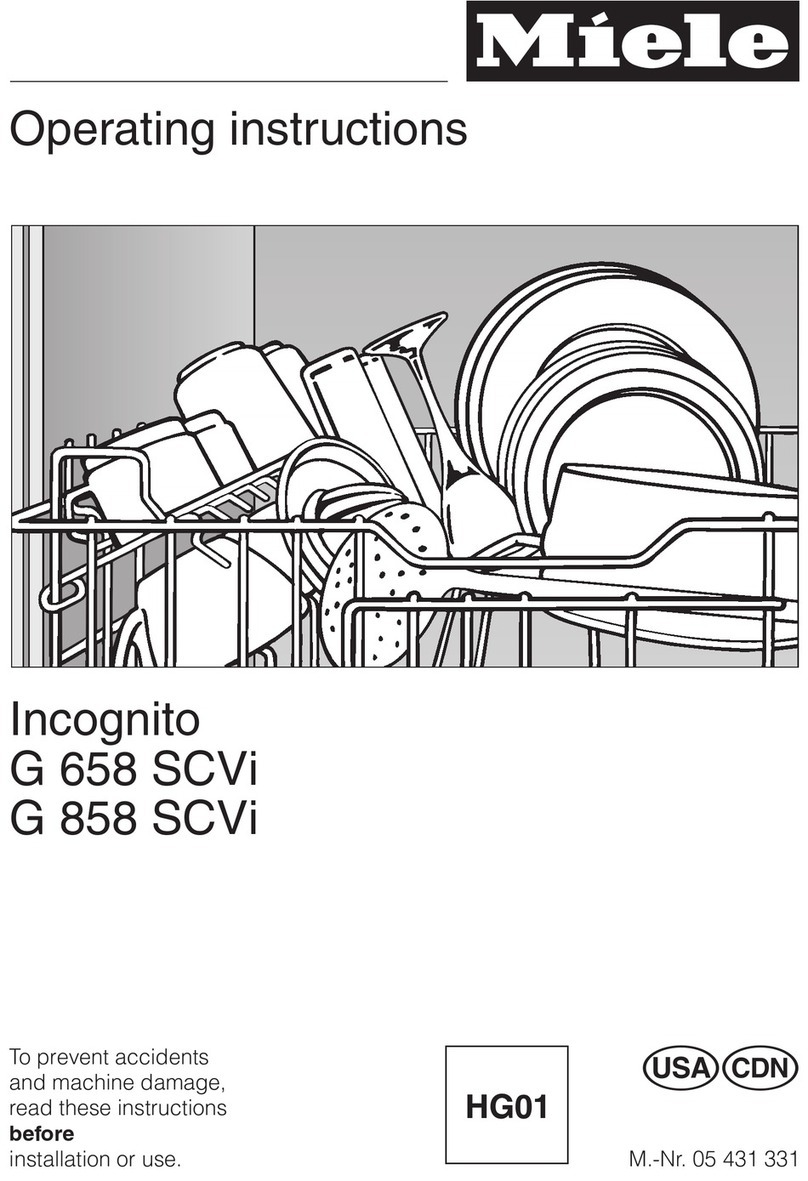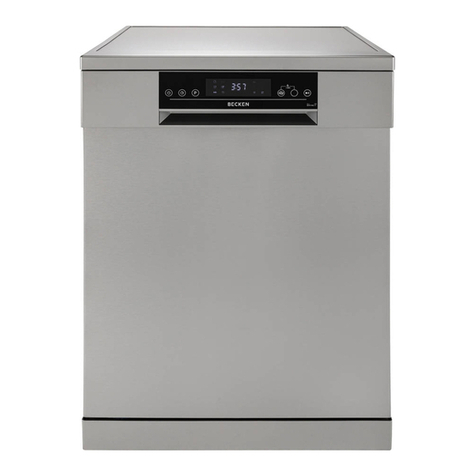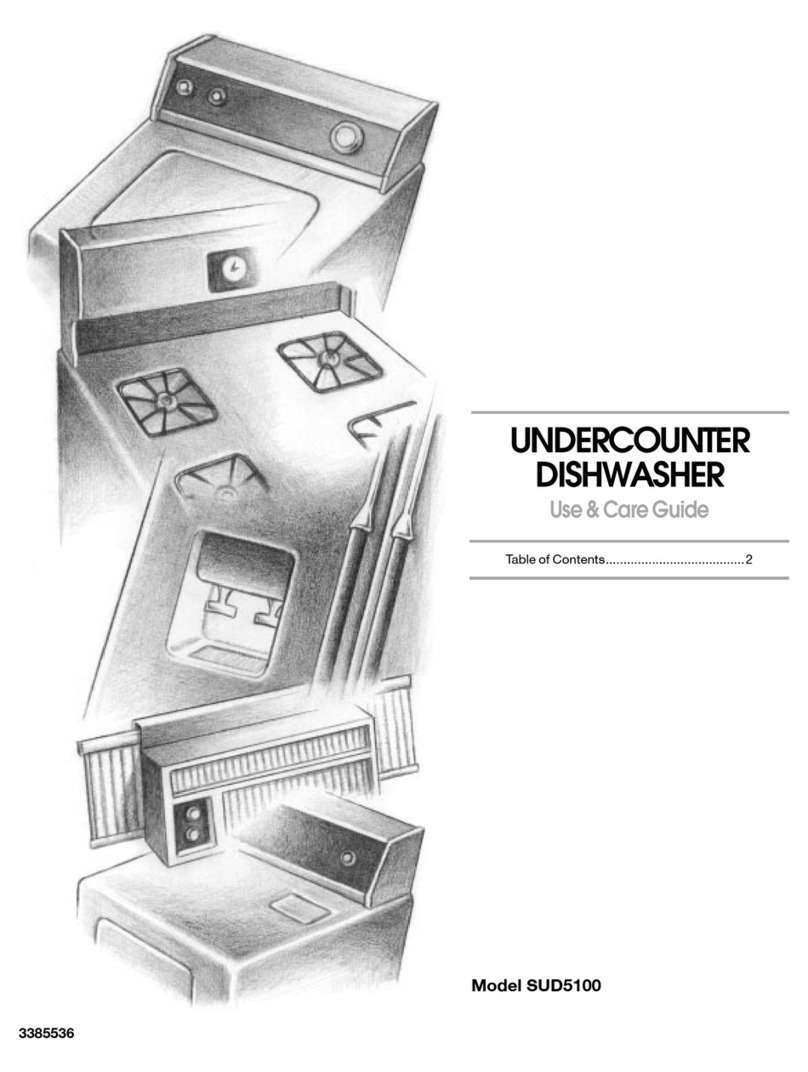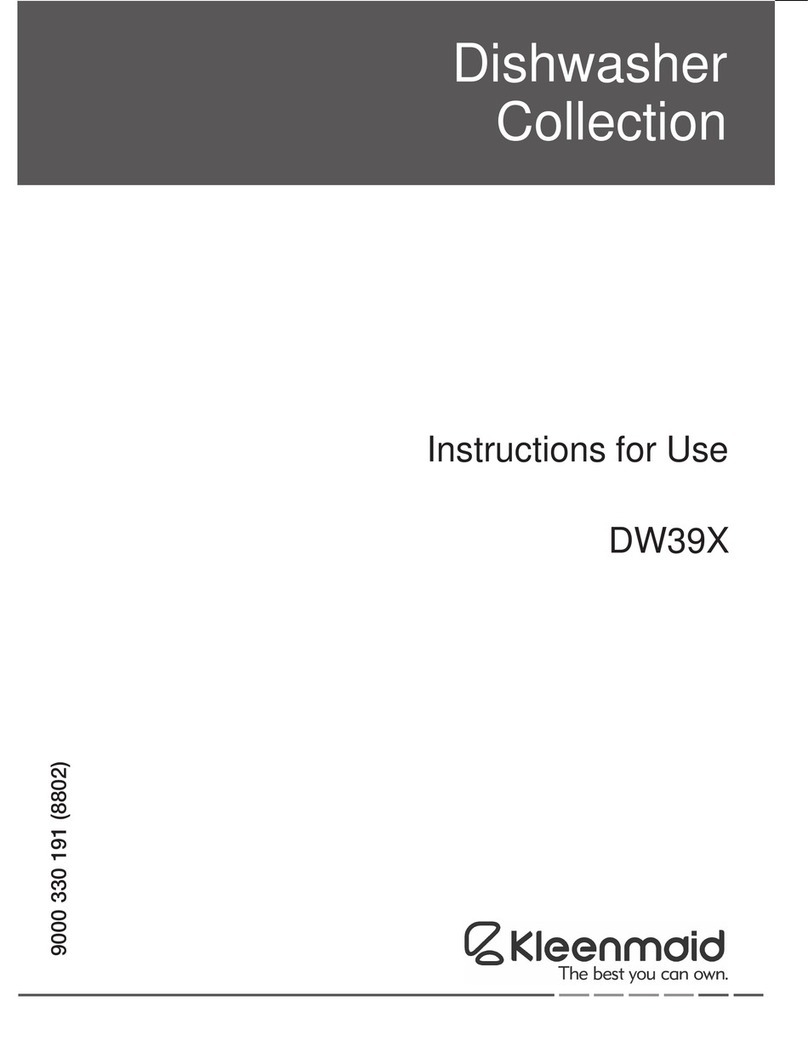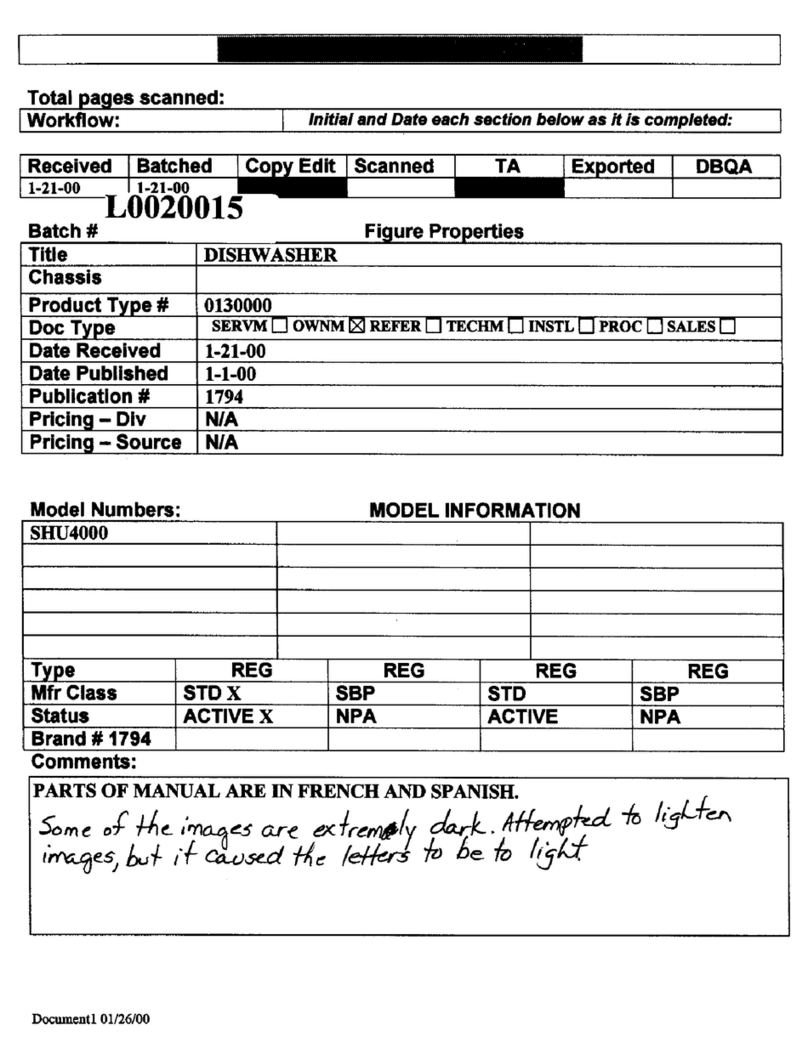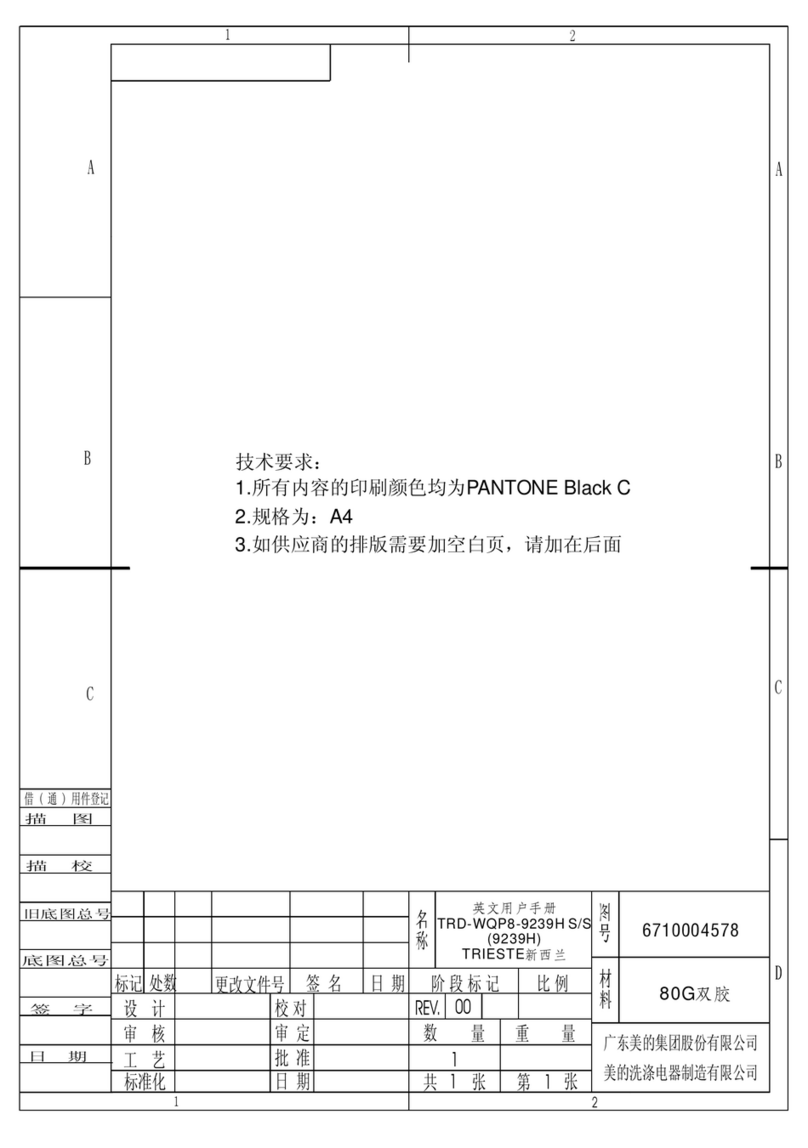Classique CLDW60SS User manual

USER MANUAL FOR YOUR CLASSIQUE
600mm Freestanding Dishwasher
CLDW60SS / CLDW60W
NOTE: This User Instruction Manual contains important information,
including safety & installation points, which will enable you to get the most
out of your appliance. Please keep it in a safe place so that it is easily
available for future reference for you or any person not familiar with the
operation of the appliance.
08
!"##$

Compartment A:
With each wash cycle.
Compartment B:
For program with pre-wash only.
(Follow the user instructions!)
Mechanical indicator C.
Electric indicator on control panel (if provided).
Check the rinse aid level
Load the baskets
Switch off the appliance
Turn off the water tap,
unload the baskets
Fill the detergent dispenser
Warning: wait a few minutes (about 15 minutes) before unloading the dishwasher to avoid handling
the dishes and utensils while they are still hot and more susceptible to break.
They will also drybetter.Unload the appliance, starting from the lower basket.
Scrape off any large amount of leftover food. Soften remnants of burnt food in pans,
then load the baskets. Refer to the dishwasher loading instructions.
When the working cycle has finished, the buzzer of the
dishwasher will sound 8 times, then stop.
Turn off the appliance using the On/Off Button.
Switch on the appliance Press the On/Off button to switch on the appliance, Open the door.
For detailed operating method read the corresponding content on the instruction manual.
Select a program
Running the dishwasher
Changing the program
Add forgotten dishes in the
dishwasher.
If the appliance is switched
off during a wash cycle.
Open the door carefully.
Hot steam m ay escape
when the do or is opened!
If the appliance is switched off during a wash cycle, whenswitched
on again, please re-select the washing cycle and operate the dishwasher
according to the original Power-on state.
1.Press the Start/Pause Button to stop the washing.
2.Open the door a little.
3.After the spray arms stop working, you can open the door completely.
4.Add forgotten dishes.
5.Close the door
6.Press the Start/Pause Button, the dishwasher will run after 10 seconds.
1. A running cycle can only be modified if it has been running forashort time. Otherwise the detergent
may have already been released and the water already drained. If this is the case, the detergent
dispenser must be refilled.
2. Press the Start/Pause button, the machine will be in standby state, press the program
button more than 3 seconds then you can change the program to the desired cycle setting
Close the door, press the Program Button until the selected program lights up.
( See the section entitled Operation instruction)]^
Turn on the water tap and press the . The machine will start working
after about 10 seconds.
Start/Pause Button
AB
C

To review the section on troubleshooting Tips
willhelp you to solve some common problems
by yourself.
Dear Customer,
Please carefully readthis manualbefore using the
dishwasher, it will help you to use and maintainthe
dishwasher properly.
Pass it on to any subsequent owner of the appliance.
This manual contains sections on safetyInstructions,
Operating Instructions, Installation Instructionsand
Troubleshooting Tips, etc.
The manufacturer, following a policy of constant
development andupdating of the product, may
make modifications without giving priornotice.
Keep it as a refer in thelater days.
If you can not solve the problems by yourself,
please ask for the help of professional technicians.
Dishwasher Features.................................... .......2
Attention before or after loading the Dishwasher
Baskets..............................................................6
Filtering System..................................................10
Caring for the Dishwasher...................................11.
A. Fill the Rinse Aid Dispenser............. .. .......3........
B. Detergent...............................................4........
...............7
The Method of Loading Normal Dishware
Wash Cycle Table.................................................8
Turning on the Appliance......................................8
Change the Program.................. ......................9....
At the End of the Wash Cycle.................................9
Packing list 12
Positioning the Appliance................... ...............12
........................................................
..
Water Connection.................................. ............13.
About Power Connection........................ ............12.
Cabinet installation 14
Before first starting................................ ...........14
.............................................
..
Before calling for service........................... ..........15.
Error codes.................................... ...................16.
Technical information.............................. ..........17..
Control Panel.......................................................2

This appliance must be grounded. In the event ofa
malfunction or breakdown, grounding will reduce
the risk of anelectric shock by providing a path of
least resistance of electric current. This appliance
is equipped with a cord having an equipment-
grounding conductor and a grounding plug.
The plug must be plugged into an appropriate outlet
that is installed and grounded in accordance with
all local codes and ordinances.
Keep children away from detergent and rinse aid, keep
child away from the open door of the dishwasher,
there could still be some detergentleft inside.
ren
Do not abuse, sit on, or stand on the door or dish
rack of the dishwasher.
Do not touch the heating element duringor
immediately after use.
(This instruction is only applicable to machines
withavisualheating element.)
Do not wash plastic items unless they are marked
dishwasher safe or the equivalent. Forplastic items
not so marked, check the manufacturer's
recommendations.
Use onlydetergent and rinse additives
designedfor an automaticdishwasher.
Never use soap, laundry detergent, or hand
washing detergent in your dishwasher. Keep
these products out of the reach of children.
During installation,thepower supply must not
be excessively or dangerouslybent or flattened.
Do not tamper with controls.
Do not place any heavy objects the
door when it is open. The appliance could tip
forward.
on or standon
Whenloading items to be washed:
1) Locate sharp items so that they are not likely
to damage the door seal;
2 Warning: Knives andother utensils with
sharp points must be loaded in thebasket
with their pointsdown or placed ina
horizontal position.
)
When using your dishwasher, you should
prevent plastic items from coming into contact
with theheating element.(Thisinstruction is only
applicable to machines with a visualheating
element.)
If the supply cord is damaged, it must be replaced
by the manufacturer or its serviceagent ora
similarly qualifiedperson in order to avoida
hazard.
Please dispose of packing materials properly.
Use the dishwasher only for its intended function.
Remove the door to the washing compartment when
removing an old dishwasher from service or discarding it.
Dishwasher detergents are strongly alkaline,they
can be extremely dangerous if swallowed. Avoid
contact with skinand eyes and keep children away
from thedishwasher whenthedoor is open.
Check that the detergent comparment is empty
after completion of the wash cycle. Theappliance is to be connected to the water
mains using newhose setsandthat old hose-sets
should not be reused.
The maximum number of place settings to be
washed is 12.
The maximum permissibleinlet water pressure is
1Mpa.
The minimum permissibleinlet water pressure is
0.04Mpa.
Children should be supervised to ensure that they do
notplay with the appliance.
This appliance is not intended for use by persons
(including children with reduced physical, sensory or
mental capabilities, or lack of experience and
knowledge ,unless they have been given supervision
or instruction concerning use of the appliance bya
person responsible for their safety.
)
When using your dishwasher, follow the precautions listed below:
Thedoor should not be left open,
since this couldincrease the risk of tripping.
Improper connection of the equipment-grounding
conductor can result in the risk of an electric shock.
Check with a qualifiedelectrician or service
representative if you are in doubt whether the
appliance is properly grounded. Do not modify the
plug provided with the appliance; If it doesnot fit
the outlet. Have a properoutlet installed bya
qualifiedelectrician.
Do not operate your dishwasher unless all
enclosure panels are properly in place. Open
the door very carefully if the dishwasheris
operating, there is a risk of water squirtingout.
Installationand repair can only be carried outby
a qualified technician.

8
Back View
1
2
3
4
5
6
7
Frontview
Dispenser
Cup Shelf
Spray arms
Filter assembly
Inletpipe connector
Drain pipe
Lower Basket
Innerpipe
Upper Basket
1
before using it for the first time.
To get the best performance from your dishwasher, read all operating instructions
4
5
6
7
8
9
3
2
9
3. Rinse aid warning light: To show when the
dispenser need to be refilled.
Water faucet light: To show when the
water faucet is forgot to turn on.
8.Start /Pause Button: To startthe selected
washing program or pause the washing program
when the machine is working.
1.On/Off Button: To turnon/off thepower supply. 5.WashingProgram Button:Press thebuttonto
select appropriate washing program.
7.Delay indicators: To show the delay time (3h/6h/9h).
6.Delay Button:Press thebutton to delaythe washing
time (you could control thedishwasher to startto
wash several hours later).
2.Power indicator: To show when the power is on.
4.Program indicators: to show which program you
have chosen.

Before using yourdishwasherfor the first time:
A. Fillthe rinseaiddispenser
B. Fill in detergent
The rinse aid is released during the final rinse to prevent water from forming droplets on your dishes, which can
leave spots and streaks. It also improves drying by allowing water to roll off the dishes. Your dishwasher is
designed to use liquid rinse aids. The rinse aid dispenser is located inside the door next to the detergent dispenser.
To fill the dispenser, open the cap and pour the rinse aid into the dispenser until the level indicator turns completely
black. The volume of the rinse aid container is about 110ml.
Rinse Aid Dispenser
Function of Rinse Aid
Rinse aid is automatically added during the last rinse, ensuring thorough rinsing, and spot and streak free drying.
Attention!
Only use branded rinse aid for dishwasher. Never fill the rinse aid dispenser with any other substances
(e.g. Dishwasher cleaning agent, liquid detergent). This would damage the appliance.
As the rinseaiddiminishes,the size of theblack dot
on the rinse aid levelindicator changes, as illustratedbelow.
Full
3/4full
1/2full
1/4full - Should refill to eliminate spotting
Empty
If there is no rinse-aid warning light in the control panel, you can judgethe amount of rinse-aid by the color of the
optical level
indicator "C" locatednext to the cap.Whenthe rinse-aid container is full, the whole indicator will be dark .As the
rinse-aid
diminishes, the size of the dark dotdecreases. You should never let the rinseaidget below 1 /4full.
When to Refill the Rinse Aid Dispenser
RINSE AID DISPENSER
To open the dispenser, turn the cap to the "open" (left) arrow and lift it out.
Pour the rinse aid into the dispenser, being careful not to overfill.
Replace the cap by inserting it aligned with "open" arrow and turning it to the closed (right) arrow.
Be careful not to overfill the dispenser, because this could causeover sudsing.Wipe away any spills
withadamp cloth. Don't forget to replace the cap before you close dishwasher door.
Attention!
Clean up any rinse aid spilt during filling with an absorbent cloth to avoid excess foaming
during the next wash.
1
2
3

Adjusting Rinse Aid Dispenser
The rinse aid dispenser has six or four settings. Always start with the dispenser
set on "4". If spots and poor drying are a problem, increase the amount of rinse
aid dispensed by removing the dispenser lid and rotating the dial to "5". If the
dishes still are not drying properly or showing spots, adjust the dial to the next
higher lever until your dishes are spot-free. The recommended setting is "4".
(Factory value is "4".)
Increase the dose if there are drops of water or lime spots on the dishes after washing.
Reduce it if there are sticky whitish stains on your dishes or a bluish film on glassware or
knife blades.
duringthe next wash. Don't forget to replace the cap before you close dishwasherdoor.
Clean up any rinseaid spilled whileduring filling with an absorbent cloth to avoid excessive foaming
Detergents with its chemical ingredients are necessary to remove dirt, crush dirt and transport it out of the dishwasher.
Most of the commercial quality detergents are suitable for this purpose.
Detergents
There are3sorts of detergents
1.Withphosphate and with chlorine
2.With phosphate and without chlorine
3.Withoutphosphateand without chlorine
Based on their chemical composition, detergents can be split in two basic types:
Detergent tablets of different brands dissolve at different speeds. For this reason some
detergent tablets cannot dissolve and develop theirfull cleaning power during short
programs. Therefore please use long programs when using detergent tablets, to
ensure the complete removal of detergent residuals.
Thedispenser must be refilled before the start of each wash cyclefollowingtheinstructions
provided in the wash cycletable.Your dishwasher uses less detergentand rinseaid than
Conventionaldishwasher. Generally, only one tablespoon of detergent is needed for
a normal wash load. More heavily soiled items need more detergent. Always addthe
detergent just before startingthedishwasher, otherwise it could getdamp and willnot
dissolve properly.
Concentrated Detergent
Detergent Tablets
Detergent Dispenser
conventional, alkaline detergents with caustic components
lowalkaline concentrated detergents with natural enzymes
Normallynew pulverized detergent is without phosphate, thusthe water softenerfunctionof
phosphate is not given. If detergents withoutphosphate were used in case of hard water
often white spots appear at dishesandglasses. In this case please add more detergent to reach
better results. Detergents without chlorinedoonlybleach a little. Strong and colored spots willnot
removed completely. In this case please choose a program with highertemperature.

Amount of Detergent to Use
Proper Use of Detergent
Use onlydetergent specifically made for the use in dishwashers. Keep your detergentfresh and dry.
Don't put powdered detergentinto thedispenser until you're ready to wash dishes.
Dishwasher detergent is corrosive! Take care to keep it out of reach of children.
Always add the detergent just before startingeach wash cycle.
Only use branded detergentand rinseaidfordishwasher.
The amount of detergent to use variesdepending on the cycle.
Please see the Wash Cycle Table on page 8.
If thelid is closed: press release button. The lid will spring open.
Fillthe detergent dispenser with detergent.
The marking indicatesthe dosing levels, as
illustrated on the right:
The place of main wash cycle detergent placed.
The place of pre-wash cycledetergentplaced.
Please observe the manufacturersdosing and storage
Recommendations as stated on the detergent packaging.
Closethe lid and press until it locks in place.
If thedishes are heavily soiled, place an additional
detergent dose in the pre-wash detergent chamber. This detergent willtake effect during the pre-wash phase.
A
B
Fill in Detergent
Please be aware that soilinglevels and water hardness can effect wash results.
Please observe thedirectionsand recommendationsfound on the chosen detergent packaging.
AB

Cutlery with wooden, horn china or
mother-of-pearl handles
Plastic items that are notheat resistant
Older cutlery with gluedparts that are not
temperature resistant
Bonded cutlery items or dishes
Pewter or cooper items
Crystalglass
Steel items subject to rusting
Wooden platters
Items made from synthetic fibres
Some types of glasses can become
dullafter a large number of washes
Silver and aluminum parts havea
tendency to discolour during washing
Glazed patterns may fade if machine
washedfrequently
Are not suitable Are of limited suitability
Dishesand items of cutlery must notlieinside one another, or cover each other.
To avoid damage to glasses, they must nottouch.
Load large items which are most difficult to clean into thelower basket.
Theupper basket is designed to hold more delicate and lighterdishware such as glasses, coffee
andtea cups
Long bladed knives stored in an uprightposition are a potentialhazard!
Long and/or sharp items of cutlery such as carving knives must be positioned
horizontally in theupper basket.
Please do not overload your dishwasher. This is importantforgood results andfor
reasonable consumption of energy.
Loadhollow items such as cups, glasses, pansetc. With the opening facing downwards so that
water cannot collect in the container or a deepbase.
Considerbuying utensils which are identified as dishwasher-proof.
Use a mild detergentthat is described as 'kind to dishes'. If necessary, seek further
informationfrom the detergent manufacturers.
Forparticular items, select a program with as low a temperature as possible.
To prevent damage, do not take glass and cutlery out of thedishwasher immediately
after the program hasended.
(For best performance of thedishwasher, follow these loading guidelines.
Features andappearance of basketsand cutlery baskets may vary from your model.)
Scrape off any large amounts of leftover food. Soften remnants of burnt foodinpans.
It is notnecessary to rinse thedishes under running water.
Placeobjects in thedishwasher in following way:
1.Items such as cups, glasses, pots/pans, etc. are faced downwards.
2.Curved items, or ones with recesses, should be loaded aslant so that water can run off.
3.All utensils are stacked securely and can not tip over.
4.All utensils are placed in the way that the spray arms can rotate freely during washing.
Very small items shouldnot be washed in thedishwasher as they could easilyfall out of the basket.
To prevent water dripping fromtheupper basket into thelower basket, we recommend that you
empty thelower basket first andthentheupper basket.

Theupper basket is designed to hold more delicate
andlighter dishware such as glasses, coffeeand
tea cupsand saucers, as well as plates, smallbowls
and shallow pans (as long as they are not toodirty).
Position thedishes and cookware so thatthey will
notget moved by the spray of water.
We suggest that you place large items andthe most
difficult to clean items are to be placed intothelower
basket: such as pots, pans, lids, serving dishesand
bowls, as shown in the figure below. It is preferableto
place serving dishesandlids on the side of the racks
in order to avoidblocking the rotation of thetop spray
arm.
Pots, serving bowls,etc, must always be placed topdown.
Deep pots should be slanted to allow water to flow out.
Please be remindedthat:
The Bottom Basket featuresfolding spikes so thatlarger or more pots andpans can be loaded.
Folding Spikes of Lower Basket
For better stacking of potsandpans,
the spikes can be foldeddown as
show in thepicture right.
Adjusting the Upper Basket
Theheight of theupper basket can be adjusted in orderto
create more space for large utensilsboth for the upper
/lower basket.Theheight of theupper basket can be
adjusted by placingthe wheels on different height of the
rails. Long items, serving cutlery, salad servers and knives
should be placed on the shelf so thatthey do notobstruct
the rotation of the spray arms..
Folding back the cup shelives
For better stacking of potsandpans,
the spikes can be foldeddown as
show in thepicture right.
Cutlery should be placed in the cutlery basket with the handles at thebottom. If the rack hasside baskets, the
spoons should be loaded separately into theappropriate slots, especially long utensils should be placed in the
horizontal position at the frontofthe upperbasket as shown in thepicture.
Do notlet any item extendthrough thebottom.
Always load sharp utensils with the sharp pointdown!

Means: need to fill rinse into the Rinse-Aid Dispenser.
()
* : This program is thetest cycle. Theinformationfor comparability test
in accordance with , as follows:
AS/NZS 2007.1
AS/NZS 2007.1
Capacity: 12 setting
Position Upper basket:upper wheels on rails
Rinse aid setting:6
Open the door slightly 50mm to assist in drying of the dishesafter every wash
Starting a cycle wash
Draw outthelower and upper basket,loadthedishes and push them back.
It is recommended to loadthelower basket first, then theupper one (see the sectionentitled
Loadingthe Dishwasher).
Pour in the detergent (see the section entitled Detergentand Rinse Aid ).
Insert the plug into the socket.Thepower supply is 220-240 VAC /50 Hz, the specification
of the socket is 10A 250VAC. Make sure thatthe water supply is turned on to full pressure.
Closethedoor, press the ON/OFF Button,andthe ON/OFF light willturn on.
Press the program button
If a program is selected,the response light willlight. Then press the Start/Pause button,the
dishwasher begins to start.
]^
]^
,the wash program will be changed as follows direction:
Intensive->Heavy-> ->Glass->1 Hour;Normal ->Rapid
1
2
3
4
5
Normal
Intensive
Heavy
(OrAll)in1
5/25g
(OrAll)in1
5/25g
(OrAll)in1
5/25g
For normally soiled loads,
such as , plates, glasses
and lightly soiled pans.
standard dailycycle.
pots
For the heaviest soiled
loads, such as pots, pans,
casserole dishes and dishes
that have been sitting with
dried food on them fora
while.
A shorter wash for lightly
soiled loads that do not
need drying.
Rapid
Pre-wash(50)
Wash (65)
Rinse
Rinse
Rinse(65)
Drying
_
_
_
Pre-wash(45)
Wash (55)
Rinse
Rinse (60)
Drying
_
_
_
Wash (55)
Rinse
Rinse(50)
Drying
Wash (40)
Rinse
Rinse (45)
_
_
165
140
135
40
1.15
0.88
1.4
0.5
18
14.5
10.5
10.5
1 Hour
Pre-wash(50)
wash(60)
Rinse (55)
Drying
_60 10
0.9
5/25g
20g
Daily wash in only 1 hour.
For lightlyand commonly
soiled platesandpans
for everyday.
(*AS/NZS 2007.1)
For heavily soiled loads,
such as pots, plates, glasses
andlightly soiled pans.
Glass
For lightly soiled loads,
such as glasses,
crystal and fine china. 20g
Pre-wash
wash(40)
Rinse
Rinse(60)
Drying
115
0.8 14.5

Whenthe working cyclehas finished, thebuzzer of thedishwasher will soundfor 8 seconds, then stop. Turn off
theappliance using the ON/OFF button, shut off the water supplyand openthedoor of the dishwasher.
Wait for a few minutesbefore unloading thedishwasher to avoidhandling thedishesandutensils while they
are stillhotand more susceptible to breakage.They will also dry better.
Switch Off the Dishwasher
The program light is on but is notblinking, only in this case the program hasended.
1.Switch off thedishwasher by pressing the ON/OFF button.
2.Turn off the watertap!
Open the door carefully.
Hot dishes are sensitive to knocks. The dishes shouldtherefore be allowed to cooldown around 15 minutes
before removing fromthe appliance.
Open thedishwasher's door, leave it ajar and waitafew minutesbefore removing thedishes. In this way they
will be coolerandthe drying will be improved.
Unloading the dishwasher
It is normal thatthe dishwasher is wet inside.
Emptythelower basket first andthentheupper one. This will avoid water drippingfromtheupper Basket onto
thedishes in the lower one.
If you open the door , the machine will pause. The program light will
stop blinking and the buzzer will sound every minute unless you close the door . After
you close the door ,the machine will keep on working after 10 seconds.
during a wash cycle
Premise:
A cyclethat is underway can only be modified if it has only been runningfor a short time. Otherwise,the
detergent may have already been released, andthe appliance may have already drainedthe wash water.
If this is the case, the detergent dispenser must be refilled (see the section entitled " Loadingthe
Detergent " ).
Press the Start/Pause button,the machine will be in standby state, press the program button more than
3s then you can change the program to thedesired cycle setting (see the sectionentitled " Startingawash
cycle" ).
1
2
Aforgottendish can be addedany time before thedetergent cup opens.
Add forgottendishes.
Closethedoor
After the spray arms stop working, you can open the door
completely.
2
3
Openthedoor a little.
14
5
6
Press the Start/Pause Button to stop the washing.
Press the , thedishwasher will run
after 10 seconds.
Start/Pause Button
When you press the Start/Pause button to pause during washing, the will
stop blinking and the dishwasher will sound every minute unless you press the
Start/Pause button to start.
running indicator
Wash the arms in soapy and warm water and useasoft brush to
cleanthejets. Replace themafter rinsingthem thoroughly.
It is dangerous to openthe door when washing,because the hot water may scald you.

The filter preventslarger remnants of food or other objects fromgettinginside thepump.
The residues may block the filter, in this case they must be removed.
The filter system consists of a coarse filter,a flat (Main filter)
And a microfilter(Fine filter).
Food and soilparticles trapped in this filter are pulverized bya
special jet on thelower spray arm and washed down to drain.
Larger items, such as pieces of bones or glass, that couldblock
the drain are trapped in the coarse filter. To remove the items
caught by the filter, gently squeeze the tap on thetop of this
filterand lift out.
This filter holds soilandfood residues in the sump area and
prevents it frombeing redeposit on the dishesduring wash cycle.
Main filter
1
Coarse filter
2
Fine filter
3
2
3
1
Filter assembly
The filter efficiently
For best performance and results, the filter must be cleaned regularly. this reason, it is a goodideato
remove thelarger food particles trappedinthe filteraftereach wash cycle by rinsingthe semicircular filter and
cup under running water. To remove the filter device, pullthe cup handleintheupward direction.
removes foodparticles fromthe wash water, allowing it to be recycledduringthe cycle.
For
Thedishwasher must never be used without the filters.
Improper replacement of the filter may reduce the performance level of the appliance
anddamage dishesandutensils.
Step 1 Turn the filter in anti-clockwisedirection,-
Step 2 lift the filter assy up!
When following this procedure from step1 to step 2, the filter system will be removed;
When following it from Step 2 to Step 1, the filter system will be installed.
1
2

The control panel can be cleaned by using a lightly dampenedcloth.
After cleaning, make sure to dry it thoroughly.
For the exterior, useagood appliance polish wax.
Never use sharp objects, scouringpads or harsh cleaners on any part of thedishwasher.
Protect Against Freezing
1.Cut offtheelectrical power to thedishwasher.
2.Turn off the water supplyanddisconnect the waterinlet pipefrom the water valve.
3.Drainthe waterfromthe inlet pipe and water valve. (Use a pan to gatherthe water)
4.Reconnect the water inletpipe to the water valve.
5.Remove the filter at thebottom of thetuband use a sponge to soak up water in the sump.
Please take frost protection measures on thedishwasher in winter. Every fter washing cycles,timea
Cleaning the Filter
Cleaning The Door
To clean the coarse filter and the fine filter, use a cleaning brush. Reassemblethe filterparts as shown in the figures
on thelast pageand reinsert theentire assembly in thedishwasher, positioning it in its seat and pressing downwards.
When cleaning the filters, don't knock on them. Otherwise, the filters could be
contorted and the performance of the dishwasher could be decreased.
To clean theedge around thedoor, you should use only a soft warm, damp cloth.
To avoid penetration of water into the doorlockandelectrical components, do not
use a spray cleaner of anykind.
Never use a spray cleaner to cleanthe door panel as it may damagethe doorlock
andelectrical components.
Abrasive agents or some papertowels shouldnot be used because of the risk of
scratching or leaving spots on the stainless steel surface.
Cleaning the Spray Arms
If your dishwasher cannot work because of the ice,
please contact professional service person.
It is necessary to cleanthe spray arms regularly forhard
water chemicals will clog the spray arm jetsandbearings.
-Inspect the filters for blocking after every time the dishwasherhas been used.
- By unscrewing the coarse filter, you can remove the filter system. Remove anyfood remnantsand
cleanthe filters under running water.
Remarks:
The entire filter assembly should be cleanedonceaweek.
To remove thelower spray arm, pulloutthe spray arm upward.
To remove theupper spray arm, holdthenut, rotatethe arm
clockwise to remove it.
Wash the arms in soapy and warm water and useasoft brush to
cleanthejets. Replace themafter rinsingthem thoroughly.

It is recommend that you run a wash cycle with the
dishwasher emptyandthen remove theplug from the
socket,turn off the water supplyandleavethe doorof
theappliance slightly open. This willhelpthedoor
seals to lastlongerand prevent odours fromforming
within theappliance.
If theappliance must be moved,try to keep it in the
vertical position. If absolutely necessary, it can be
positioned on its back.
One of thefactorsthat cause odours to form in the
dishwasher is foodthat remainstrapped in the seals.
Periodic cleaning with a damp sponge will preventthis
from occurring.
Ensure the voltageandfrequency of thepower being correspondsto
those on the ratingplate. Only insert the pluginto an electrical socket which is earthed
properly. If the electrical socket to which theappliance must be connected is not
appropriate fortheplug , replace the socket, rather than using a adaptors or the like as
they could cause overheating andburns.
Please look at the rating label to knowthe rating voltageand connect thedishwasher to theappropriate power supply.
Use the required fuse 10 amp, time delay fuse or circuit breaker recommendedand provide separatecircuit serving
onlythis appliance.
Position theappliance in thedesired location.The back should rest against the wallbehind it, and thesides,
along theadjacent cabinets or walls. Thedishwasher is equipped with water supplyand drain hoses that can
be positioned either to the right or theleft sides to facilitate proper installation.
You must not install a dishwasherunderneath a cooktopunless there is no break in thekitchen benchtop such
that no hazards are generated.
Once the appliance is positioned for levelling, the height of the dishwasher
may be altered viaadjustment of the screwinglevel of thefeet. In any case,
theappliance shouldnot be inclined more than2.
For personal safety:
DO NOT USE AN EXTENSION CORD OR AN ADAPTER PLUG WITH THIS APPLIANCE.
DO NOT, UNDER ANY CIRCUMSTANCES, CUT OR REMOVE THE EARTHING
CONNECTION FROM THE POWER CORD.
Before cleaning or performing maintenance, always
remove theplugfromthe socket.
To clean the exterior and rubberparts of the dishwasher,
do not use solvents or abrasivecleaning products.
Only use a cloth with warm soapy water.
To remove spots or stainsfromthe surface of the
interior, use a cloth dampened with water analittle
vinegar, or a cleaning product made specifically for
dishwashers.
Remove the Plug
No Solvents or Abrasive Cleaning
Moving the Appliance
Seals
After every wash, turn off the water supply to the
applianceand leave thedoor slightly opensothat
moisture and odours are nottrappedinside.
After Every Wash When not in Use for a LongTime
This appliance must be earthed. In the event of a malfunction or breakdown, earthing will reduce the risk of
electric shock by providing a path of least resistance for the electric current. Thisappliance is equipped witha
cord having an equipment-earthing conductor andanearthingplug. Theplug must be plugged into an
appropriate outlet that is installed and earthed in accordance with all local standards and requirements.
Open the carton box, you will findthefollowing items:
1. Dishwasherunit with drainhose, power cord andplug: 1 pcs.
2. Upper basket:1Pcs
3. Lower Basket: 1 Pcs
4. Cutlery basket: 1 Pcs
5. Cup holder: 2 Pcs
6. Waterinlet hose: 1 Pcs
7. User Manual:1Pcs
8. Attention cards: 2 Pcs

for personal safety:
DO NOT USE AN EXTENSION CORD OR AN ADAPTER PLUG WITH THIS APPLIANCE.
DO NOT, UNDER ANY CIRCUMSTANCES, CUT OR REMOVE THE
FROM THE POWER CORD.
EARTHING
CONNECTION
Connect the cold water supplyhose to a threaded 3/4(inch) connector and make sure
that it is fastened tightly in place.
If the waterpipes are new or have notbeen used for an extendedperiod of time, letthe
water run to make sure thatthe water is clear. This precaution is needed to avoid the
risk of the waterinlet to be blocked and damage the appliance.
Improper connection of the equipment earthing conductor can result in the risk of an
electric shock.
Check with a qualified electrician or service representative if you are in doubt whether the
appliance is properly earthed.
Do not modify the plug provided with the appliance. If the plug does not fit properly to the
outlet, please have a qualified electrician to install a proper outlet.
Please close the hydrant after using.
Insert the drain hose into a drain pipe with a minimum diameter of 40mm, or let it run intothesink, making sure to
avoid bending or crimping it. Thetop of the hose must be less than 1000mm.
A
Counter
Front
Drain pipe
NOTE
The top of the hose
must be less than
1000mm.
40mm
B

The following things should be checked before starting the dishwasher.
The content of this manual is very helpful to the users.
After installation, please make sure to keep this manual.
1The dishwasher is level and fixed properly.
2The inlet valve is open.
3There is no leakage at the connections of the conducts.
4The wires are tightly connected.
5The power is switchedon.
6The inlet and drain hoses are not knotted and kinked.
7All packing and printing materials should be taken out of the dishwasher.
Extension Hose
If you needadrain hose extension, make sure to use a similar drain hose.
It must be no longer than 4 metres; otherwisethe cleaning effect of the dishwasher could be reduced.
Water Outlet
Connect the water drain hose. The drain hose must be correctly fitted to avoid water leaks.
Ensure thatthe water drainhose is not kinked or squashed.
If thesink is 1000mm higherfromthe floor, the excess water in hoses cannot be draineddirectly
into the sink. It will be necessary to drain excess waterfromhoses into a bowl or suitable
containerthat is heldoutside andlower thanthe sink.
How to Drain Excess Water From Hoses
Syphon Connection
The waste connection must be at a heightlessthan1000 mm (maximum) fromthebottom of thedish.
The water drain hose should be fixed.
Cabinet installation
Wheninstallingthedishwasher into cabinetry, be sure to observe the minimum space requirements as shown
in thebelow diagram.

Fuse blown, or the
circuit breaker triggered
Replace fuse or reset circuit breaker. Remove anyother
appliances sharingthe same circuit with thedishwasher
Spilled rinse-aid Always wipe up rinse-aid spills immediately.
Hard water minerals
The affected items are
not corrosion resistant.
A sp ay arm is
knockingagainst
an item in a basket
r
Items of crockery
are loose in the
wash cabinet
This may be caused
by on-site installation
or the cross-sectionof
thepiping.
To cleantheinterior, use a damp sponge with
dishwasherdetergentand wear rubbergloves.
Never use anyother cleanerthandishwasher
detergentforthe risk of foaming or suds.
Interrupt the program, and rearrangethe items
which are obstructingthe sp ay arm.r
Interrupt the program,
and rearrangethe items of crockery.
This has no influence on thedishwasherfunction.
if in doubt, contact a suitablyqualifiedplumber.
Detergent with
colourant was used
Make sure that the detergent is the one without
colourant.
Improperdetergent
Make sure thedishwasher is turned on and the dooris
closed securely.
Check thatthe water supply is connected properly and
the water is turnedon.
Make sure to close the door properly andlatch it.
Make sure thepower cord is properly pluggedinto the
wall socket.
Power supply is not
turnedon
Water pressure is low
Door of dishwasher
not properly closed.
Kink in drainhose
Filterclogged
Kitchen sink clogged
Check drainhose.
Check coarse the filter
(see section titled)" Cleaning The Filter"
Check thekitchensink to make sure it is draining well.
If the problem is thekitchensink not draining ,you may
need a plumber ratherthan a serviceman fordishwashers.
Use onlythe special dishwasher detergent to avoid suds.
If this occurs, openthedishwasher and let suds evaporate.
Add 1 gallon of cold water to the tub. Close and latch the
dishwasher, then select any cycle. Dishwasher will drain
outthe water at the first step.Open the door after draining
is stopand check if the suds is disappeared.
Repeatifnecessary.
The items should be corrosion resistant.

Thedishes were not
loaded correctly.
Loadthedishwasher as shown in this user manual
Select a more intensive program.
See" Wash Cycle Table."
Use more detergent, or change yourdetergent.
Rearrange the items so that the sp ay can rotatefreely.r
Cleanand/or fit the filter combination correctly.
Cleanthe sp ay arm jets. See "Cleaningthe Spray
Arms".
r
Use lessdetergent if you have soft waterand select
a shortest cycle to wash the glassware andtoget
themclean.
Use a mildabrasive cleaner to eliminate those marks.
Re-loadingthedishes properly.
Loadthedishwasher as suggestedinthedirections.
Increase the amount of rinse-aid/refillthe rinse-aid
dispenser.
Do not empty yourdishwasher immediatelyafter
washing. Openthedoorslightly so thatthe steam can
escape. Begin unloading the dishwasheronlyoncet
he dishes are barely warm to thetouch. Empty the low
basket first. This prevents waterform dropping off
dishes in theupperbasket.
In short program the washingtemperature is lower.
This also lowers cleaningperformance. Choose
a program with a long washing time.
Water drainage is more difficult with these items.
Cutlery or dishes of this type are not suitablefor
washing in thedishwasher.
The program was
notpowerful enough.
Not enoughdetergent
was dispensed.
Items are blocking
thepath of sp ay arms.r
The filter combination
in the base of wash
cabinet is notcleanor
is not correctly fitted.
This may cause
the sp ay arm jets
to getblocked.
r
Combination of soft
water andtoo much
detergent.
Aluminumutensils
have rubbedagainst
dishes.
Dishes block
detergent cups.
Improperloading
Too little rinse-aid
Dishes are removed
too soon
Wrong program
hasbeen selected
Use of cutlery with
a low-quality coating
Overflow.
When some malfunctions come on, the appliance will display error codes to warn you:
Longer inlet time. Faucets is notopened, or waterintake is
restricted, or water pressure is toolow.
Some elementofdishwasherleaks.
The Rapid light flicker fleetly
The Glass light flicker fleetly

If overflow occurs, turn off the main water supply before calling a service.
If there is water in the base pan because of an overfill or small leak,
the water should be removed before restarting the dishwasher.
Height : 845mm
Width : 598mm
Depth : 605mm
Voltage connected Load : 220-240V/50Hz.
Water pressure: 0.04-1.0MPa
Power supply: 1760-2100W
Capacity: 12 Place settings
Where to find your model number and serial number
Yourappliancehas a dataplatethat providesidentifying information that is important to know when registering your
purchase onlineandfor service. You can findthe data plate on the rightinside edge of thedishwasherdoor.
This manual suits for next models
1
Table of contents
Other Classique Dishwasher manuals




